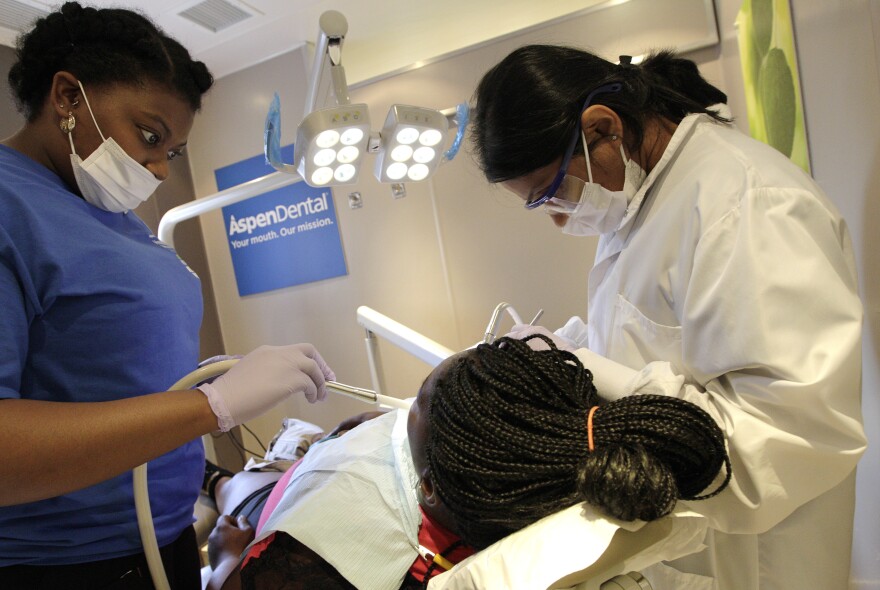More than half of Ohio counties don’t have enough dentists for the population. Numbers show the dental shortages are especially severe in many rural and low-income communities.
Ann Naber, a member of the Ohio Dental Hygienist Association (ODHA) and an instructor at Sinclair Community College, says this lack of access can lead to severe – and often expensive – health consequences for many people.
"They end up in the emergency room with dental pain and dental infection,” Naber says. “If they have to be admitted because it’s a severe infection, it can cost thousands of dollars. Dental infection affects your entire body, it affects your overall health.”
To close this dental care gap, some states are experimenting with a new approach called “dental therapy.”
Dental therapists are mid-level providers of dental health services. They have less training and are paid less than dentists, but they’re able to perform some routine dental procedures dental hygienists and assistants can’t.
Dental therapy originated in New Zealand in 1921. A handful of U.S. states have recently legalized the practice. In those states, according to Naber, it’s resulted in healthier patients and lower costs.
“There are over 54 countries with dental therapists, the practice has been around nearly 100 years and there are 1,100 studies validating it,” she says.
Steve Wagner of UHCAN Ohio, the Universal Health Care Action Network, says the use of dental therapists could help increase access to dental care in underserved communities and make that care cheaper for both providers and patients.
"So, what that means for a practice," he says, "is that the dentist then can concentrate on the more intense procedures and the dental therapist can focus on the lower-reimbursed procedures, and the routine things within their scope – and practices can actually do better than they do now seeing Medicaid patients."
State Sens. Peggy Lehner of Kettering and Cecil Thomas of Cincinnati are sponsoring legislation that would legalize dental therapy and license dental therapists to practice in the state of Ohio.
Under the bill, SB 98, dental therapists would work under the supervision of a dentist but could perform 35 routine procedures independently. They’d also be required to serve lower-income Ohioans and others living in dental shortage areas.
But not everyone is convinced legalizing dental therapy makes sense. The Ohio Dental Association has come out strongly against the legislation.
Dr. Matthew Messina, a member of the Ohio Dental Association and a professor at Ohio State University’s dental school, says allowing dental therapists to treat patients could be dangerous.
“They're looking at trying to create a kind of ‘dentist-lite’ – somebody with less training – and then empowering them to do procedures, up to and including drilling cavities and extracting teeth,” Messina says. “And these are irreversible surgical procedures that patients in Ohio deserve the quality of care from a highly trained dentist.”
Messina is in favor of another dental-related bill currently under consideration at the Statehouse, HB 184, which passed the House in October with bipartisan support. That bill would give expanded capabilities to existing members of dental teams, such as dental assistants, and increase funding for teledentistry, which allows dentists to see patients virtually through video chatting.
“The therapist approach is a diversion from what's currently working and is rapidly improving in an effort to try and do something that looks new, or looks fresh and different,” Messina says. “But actually the tried and true and stepwise process is working better.”
Messina says Ohio State is already helping to address the dentist shortage by adding 10 new student slots to its dental programs.
The number of dentists in Ohio has increased over the past few years, but the number of dental-provider shortage areas in the state has gone up, too. In 2011, there were about 59 shortage areas. Now, that number is closer to 100.
Naber says the increase could be attributed population shifts, and dental providers clustering in certain areas of the state.
“Cuyahoga County, Cleveland, has 12 shortage areas,” she says. “You’d think it’s a metropolitan area, they’re not going to have any shortage areas, but they do. We need comprehensive therapeutic care that’s affordable, that everyone can get.”
It could be awhile before we see any changes to the state’s dental care system. No hearings in the Ohio Senate have been scheduled for either dental health bill.
And even if state lawmakers eventually move forward with legalizing dental therapy, Naber says it could be years before dental therapists are trained and ready to see patients.




